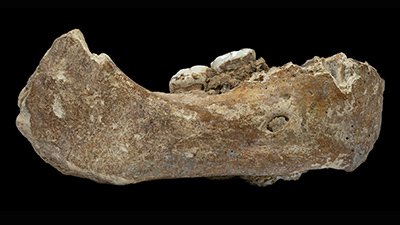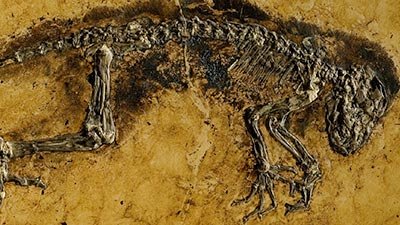Hominids
Labeling the Hominids
It seems these days that there are precious few ordinary human or ape fossils unearthed, rather they all have to be a missing link between the two. One should be wary of claims that this or that skeletal feature “proves the creature walked upright”, as usually some other evolutionist fossil “expert” will debunk or dispute the claim.
Homo erectus and Other Hominids
Human fossils of people who dispersed from Babel are found in various layers of Pleistocene rocks. Biblically we understand that a variety of people dispersed from Babel, and these human fossils track their scattering around the globe. The oldest and deepest of these human fossils—Homo erectus—were just as human as we are.
Variety Among Hominid Fossils
The existence of human variations in fossils is not evidence that humans evolved through an evolutionary sequence. A better question would involve an exploration of the diversity among humans descended from Noah’s family after the tower of Babel.
Articles About Hominids
-
May 17, 2019 from Answers in Depth
The first Denisovan fossil outside Siberia has been found. What are Christians to think of this mysterious people group?
-
In-Depth ArticleHobbits of Flores Were an Archaic Human Variety, Studies SuggestJuly 15, 2016 from Answers in Depth
Could hobbits be a dwarfed variety of Homo erectus, an archaic human whose presence in Southeast Asia, specifically Flores, has been demonstrated?
-
Magazine Department ArticleGibbon the Opportunity . . .April 1, 2016 from Answers Magazine
A recently discovered fossil of a gibbon-like creature is being hailed as a missing chapter in the history of apes, which evolutionists believe split into different lines before humans evolved. But is Pliobates cataloniae, found near Barcelona, really a long-lost cousin of ours?
-
Magazine Department ArticleGetting a Grip on Human OriginsJan. 1, 2016 from Answers Magazine
Evolutionary researchers presented another landmark study claiming that chimpanzee hands are more advanced than human hands.
-
Jan. 1, 2016 from Answers Magazine
The Naledi skeletons in South Africa, whose discovery was announced last September, represent the latest species declared to be a likely human relative.
-
In-Depth ArticleTale of the Taung Child CollapsesOct. 7, 2014 from Answers in Depth
“Evolving room for the brain to grow” was a good story, but even for evolutionists it doesn’t hold water anymore.
-
In-Depth ArticleFossil Hand Turns Back the Clock on Tools for Human EvolutionJan. 25, 2014 from Answers in Depth
Hand fit for a human found surprisingly deep in the fossil record.
-
In-Depth ArticleNutcracker Man’s Diet Was Rich in Brain Food After AllJan. 21, 2014 from Answers in Depth
Bright baboons know nutritional needs of “Nutcracker Man” were no problem.
-
In-Depth ArticleBuilding Nutcracker Man from the Ground UpJan. 18, 2014 from Answers in Depth
New “Nutcracker Man” is a mosaic of evolutionary assumptions and reality.
-
In-Depth ArticleDid Ardi Head Up Human Evolution Before Lucy?Jan. 16, 2014 from Answers in Depth
Ardi’s diminutive skull said to have evolved some human features a million years before Lucy.
-
Sima de los Huesos Reveals Surprising Genetic ConnectionsDec. 16, 2013 from News to Know
The “Pit of Bones” in a cavern in northern Spain was the final resting place for 28 of Europe’s earliest human inhabitants, Homo heidelbergensis.
-
Semi-Technical In-Depth ArticleDoes the Dmanisi Discovery Demonstrate We Are All One Family?Nov. 6, 2013 from Answers in Depth
Does the curious mosaic cobbled from the Dmanisi dig demonstrate we are all one family?
-
Magazine Department ArticlePutting a Face on EvolutionJan. 1, 2013 from Answers Magazine
The bones found at Lake Turkana, then, must represent descendants of people who lived after the tower of Babel.
-
“Homo” Diversity or “Homo” Ancestry?Dec. 22, 2012 from News to Know
Homo diversity versus Homo ancestry: asking the right question
-
-
Enigmatic Skull Confirmed to Have Flat FaceAug. 11, 2012 from News to Know
Enigmatic KNM-ER 1470’s flat face finally confirmed.
-
Dispute Over Largest Group of Human FossilsJune 16, 2012 from News to Know
Identity and age of the world’s largest group of human fossils is in dispute. “Getting that wrong even affects how we construct our own evolution,” says evolutionary expert.
-
Supposed Hominid EvolutionMay 5, 2012 from News to Know
Weird walkers weigh in on supposed hominid evolution.
-
Magazine Department ArticleA Tough Nut to CrackOct. 1, 2011 from Answers Magazine
Since its discovery in 1959, Nutcracker Man has usually been depicted as walking upright (though only a skull had been discovered).
-
Number CrunchingJune 11, 2011 from News to Know
Smile, crunch the numbers, and make something out of nothing.
-
-
Meet the DenisovansJan. 8, 2011 from News to Know
Neanderthals, move aside; it’s time for us to meet your cousins, the “Denisovans.”
-
Relative of Ape-Woman Lucy?June 26, 2010
He’s the new “big man” of human evolution: Kadanuumuu, a purported relative of famous ape-woman Lucy.
-
Ancient Human CannibalMay 29, 2010
Add to the list of ancient humans Homo gautengensis, a chimp-like creature that may have had a dark past.
-
“X-Woman” to be Added to Human LineageMarch 27, 2010
Neanderthals, move over: there may have been another “human lineage” walking on earth in recent history, known only from an individual called “X-woman” (elsewhere reported as “Woman X”)
-
Magazine Department ArticleMeet “Ardi”Jan. 1, 2010 from Answers Magazine
“Ardi” does away with conventional ideas about a missing link.
-
Monkey Not Our UncleOct. 24, 2009 from News to Know
Remember “Ida,” the missing link that wasn’t? In a Nature letter, scientists attack the lofty claims that surrounded the announcement of the fossil primate.
-
-
Meet “Ardi”Oct. 2, 2009
Evolutionists aren’t yet sure if they should call it a human ancestor, but one thing they do know is that “Ardi” does away with the idea of a “missing link.”
-
Oct. 1, 2009 from Answers Magazine
Ida appears to be a remarkably well-preserved lemur, not a human ancestor.
-
Skull Rewrites the BookSept. 12, 2009 from News to Know
The history of human evolution is clear: we all came from Europe.
-
Lord of the ToolsApril 25, 2009 from News to Know
“How could a hominid with a brain the size of a grapefruit craft tools?” asks ScienceNOW’s Elizabeth Culotta.
-
Toeing the LineMarch 7, 2009 from News to Know
A fossilized footprint found in Kenya—thought to be 1.5 million years old—doesn’t look its age.
-
Early Humans Born With Big BrainsNov. 22, 2008
It’s yet another human ancestor—but, once again, with a larger brain than us.
-
Bones Don’t Add Up For Palauan HobbitsSept. 6, 2008 from News to Know
News broke last week of the misinterpretation of Palauan bone fragments, which had led to the misidentification of a modern human as something else. It isn’t the first time!
-
Hominid Fossil Finder Disputes Age of His FindSept. 6, 2008
After years of thorough dispute from creationist circles, the controversial Toumai skull—said to be the remains of an apeman—is now under another attack from evolutionists.
-
Cro-Magnon Man DNA Similar to that of Modern HumansJuly 19, 2008
Cro-Magnon Man, you may be 28,000 years old, but you haven’t changed a bit!
-
First Walking Human Determined to be Six Million years OldMarch 29, 2008
A new analysis of the bones of a human “ancestor” suggests it was the earliest known hominin to walk upright, reports National Geographic News.
-
Magazine Department ArticleHominid Hopes DashedJan. 28, 2008 from Answers Magazine
For several years, evolutionists have hailed the find nicknamed Toumai as the missing link between humans and an ape-like ancestor.
-
Missed the Memo; Forgot to Leave AfricaNov. 17, 2007
A new fossil found in Kenya’s Rift Valley is shaking up the latest hypotheses about alleged ancient apes and their postulated connection to modern humans, chimpanzees, and gorillas.
-
Review of New Fossils Found in GeorgiaSept. 22, 2007 from News to Know
A team reporting this week in the journal Nature announces the discovery of the remains of four individuals found at the site of a medieval castle at Dmanisi in the former Soviet republic of Georgia.
-
Living With Your AncestorsAug. 11, 2007
Evolutionists are busy rewriting the story of the evolution of humankind becuase of two fossils from Kenya.
-
Magazine Department ArticleThe Mother Lode of Ancestral MomsJuly 30, 2007 from Answers Magazine
Could it be that many evolutionists are scrambling to counter the increasing influence of the creation and intelligent design movements in today’s culture?
-
Magazine Department ArticleKenyan ControversyJuly 1, 2007 from Answers Magazine
Some well-intentioned but misguided Christians in Kenya have raised opposition to a new evolution display in their country’s National Museum.
-
Magazine Department ArticleSkull ScratchingJuly 1, 2007 from Answers Magazine
In the evolutionary worldview, people have been slowly evolving—and improving—over millions of years. According to biblical anthropology, however, humans were created on the sixth day of creation.
-
Skull Exhibits Confusing CharacteristicsJan. 20, 2007
A skull discovered in Romania is causing some head-scratching among evolutionists because it includes “traits normally associated with more ancient species” even though it is “undeniably a Homo sapiens specimen.”
-
Magazine Department ArticleRead the Fine PrintNov. 20, 2006 from Answers Magazine
While headlines often trumpet “Scientists find skull of human ancestor", you need to read on.
-
The Toumaï Skull: Ape or Human Ancestor?Aug. 30, 2006
In 2001, a chimp-sized cranium (lacking the lower jaw) was discovered in the Djurab Desert in the central African nation of Chad.
-
Fact Versus Fiction: The Recent Ethiopian FossilsApril 17, 2006
The Asa Issie fossil discovery is just one more of evolutionists false interpretations of the fossil record in an attempt to “prove” an animal origin for humans.
-
Hominid FeverMarch 11, 2005
It seems these days that there are precious few ordinary human or ape fossils unearthed, rather they all have to be a missing link between the two.

Answers in Genesis is an apologetics ministry, dedicated to helping Christians defend their faith and proclaim the good news of Jesus Christ.
- Customer Service 800.778.3390
- Available Monday–Friday | 9 AM–5 PM ET
- © 2025 Answers in Genesis




